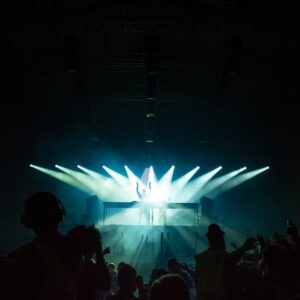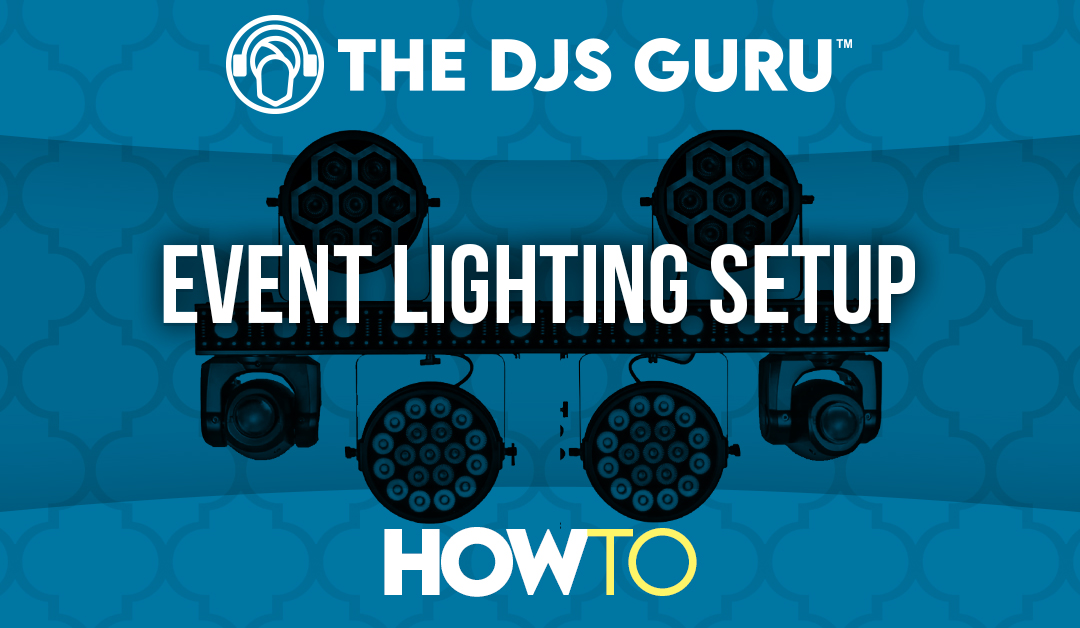After buying a DJ mixer or controller, most DJs turn to sound and lighting for their next purchases. DJ lighting is a huge market, with dozens of lighting types and hundreds of models. Many DJs simply buy a handful of lights that look interesting to them. Unfortunately, this can lead to a disorganized light show that lacks any structure. If you want to stand out from other DJs in your market, you need to put thought into your lighting. In this article on mobile DJ light show basics, we’ll give a brief overview of how to spice up your light show.

Mobile DJ Light Show Basics – First steps
Step one is to find lights you like and purchase them. The second step is finding a way to hang or mount them so they are aimed appropriately at the crowd. If you haven’t yet, make sure to check out our Ultimate DJ Lighting Buying Guide for info on these steps.
Step three is the most important – using your DJ lights effectively. Simply buying a dozen DJ lights and stringing them across a T-bar will NOT make your DJ business stand out. Instead, you should employ some basic lighting design tactics for maximal impact.
Clean up your setup
The first thing you should do is clean up your setup. Nothing screams beginner or inexperienced DJ like a messy setup. While plenty of DJs will debate you on Facebook about it, the fact of the matter is this – your image says a lot about your company. Many of the ways you can improve your light show don’t cost anything.
Use cable ties to tidy up loose wires that are dangling down. Buy smaller extension and IEC cables if your lights have power daisy-chaining available. You don’t need a 6-foot power cable if your lights are right next to each other. Make sure your stand or truss is not excessively scratched. While I’m not a huge fan of scrims, some DJs like the look and the fact that they hide your wires. Use matching lighting clamps and cables to ensure uniformity.
Mobile DJ Light Show Basics – Positioning and symmetry
Use symmetry to your advantage
The law of symmetry is essential to good lighting design. Humans are drawn to symmetry. When creating a light show, buying lights in pairs or multiples of two is a good choice. This way, you can space your lights evenly across your lighting stand or truss. Think of the last concert you went to – the lighting was not made up of a hundred different types of effects, but rows of repeating lights that worked in sync together. Having two wash lights and two moving heads looks more professional than having a single moonflower, laser, moving head, strobe, par, and beam light all running at the same time.
Use alternate light positioning
Don’t settle for simply putting your lights in a straight line across your stand. Brainstorm creative ways you can position your lighting that is outside the norm. Perhaps you position two lights above your T-bar and two below. Maybe you alternate wash, moving head, wash, moving head. You could even put lights on both the horizontal bar and vertical support of your lighting stand.
Moving lights off of your lighting stand and into other areas of your setup can add variety. Consider placing lights on top of the speakers. Make sure to use the fly point bolt holes to keep them secure! You could also place lights directly underneath your speakers with clamps. Many wedding and corporate DJs utilize totems to space out and elevate their lighting. The goal? Try anything that makes your setup unique and different without being distracting.
Mobile DJ Light Show Basics – Variety
One of the biggest reasons DJs fail to create a memorable light show is laziness. The easiest route of adding lighting to your DJ business is to simply buy a couple of lights, put them up, and turn them on. That’s it. Most DJs plug things in and walk away. Does it work? Sure. But you surely aren’t turning any heads in the lighting department. It doesn’t matter if you followed the above steps, tidied up your setup, and followed the rule of symmetry. If your light show is chaotic and uncoordinated, it will become tiresome quickly.
You don’t need to know DMX to take control of your light show. A simply switching power supply will allow you to turn certain lights on and off from your DJ booth. By simply alternating which lights are running throughout the night you will add variety to your show. Run the wash for the first few songs of the night. After a while add in an effect light. Then add a second. Maybe turn the wash light off for one high-energy song. Then turn the wash on and the first effect off. Now, instead of seeing the same thing nonstop the entire night, the crowd notices the changes. Combined with smooth mixing, this is an effective way to keep people on your dance floors.
One last thing – if you are using multiple lights of the same model (and not using DMX control), ALWAYS master-slave those lights together. Two lights doing slightly different but similar light shows look sloppy and lazy. Some lights even have an option built-in to flip the effects or movements on the second light. BOOM! Instant upgrade to your light show.
Contrast
In addition to switching lights on and off, you can make your light show stand out by utilizing contrast. Hot and cold. Black and white. Off and on. All of these are examples of high-contrast opposites. When it comes to lighting, most DJ light shows lack contrast. Four different RGB effect lights that all project spinning, high-speed beams simply blend together.
Instead, try and utilize effects and colors that contrast with each other. Look up a color wheel to see what colors lie opposite each other (blue and yellow are great examples). Use white beam lights with colored washes or vice versa. If your lights have been on a fast-moving program for a while, follow it up with a slow-moving automatic or sound-active program. By breaking up the monotony with contrast, people will notice your lighting more.
Mobile DJ Light Show Basics – Wrapping Up
Hopefully, you’ve found this brief intro to mobile DJ light show basics helpful. In reality, this is a drop in the bucket when it comes to lighting design. Be sure to follow The DJs Guru for more articles about lighting, tips, and tricks for taking your mobile DJ business to the next level.


